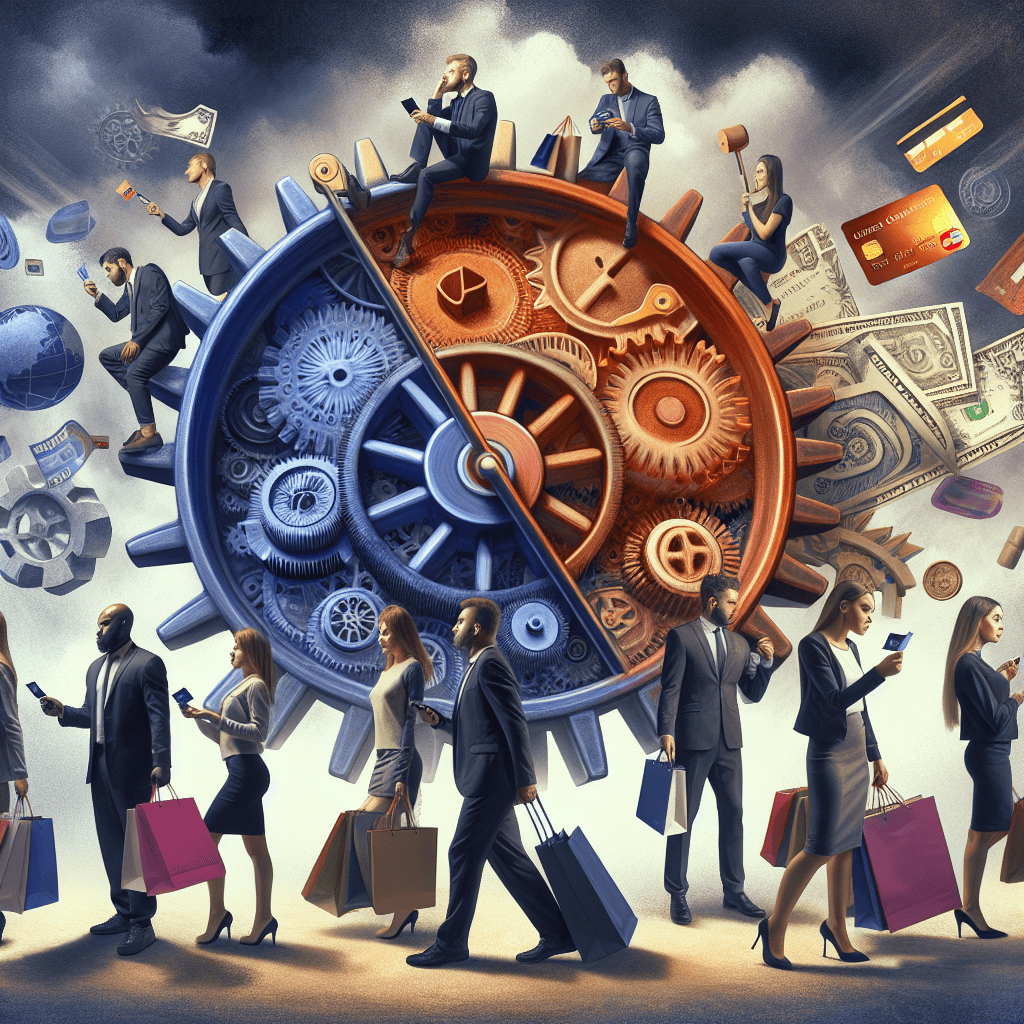“Unseen Influence: Harnessing the Silent Force of Consumer Power in Today’s Economy”
Introduction
“The Quiet Surge of Consumer Power: A Key Economic Driver in Focus” explores the transformative role of consumer influence in shaping modern economies. As traditional economic models evolve, the subtle yet profound impact of consumer behavior and preferences has emerged as a pivotal force driving market dynamics. This analysis delves into how empowered consumers, armed with information and choice, are reshaping industries, dictating trends, and compelling businesses to innovate and adapt. By examining the mechanisms through which consumer power is exerted, this piece highlights its significance as a catalyst for economic growth and transformation in an increasingly interconnected global marketplace.
Understanding Consumer Power: The Silent Economic Force
In recent years, the concept of consumer power has emerged as a pivotal force in shaping economic landscapes across the globe. This quiet surge of influence, often underestimated, plays a crucial role in driving market dynamics and influencing corporate strategies. As we delve into understanding consumer power, it becomes evident that this silent economic force is not only reshaping industries but also redefining the relationship between businesses and their customers.
To begin with, consumer power is fundamentally rooted in the choices and preferences of individuals. In an era where information is readily accessible, consumers are more informed than ever before. This access to information empowers them to make decisions that align with their values and expectations. Consequently, businesses are compelled to adapt to these evolving preferences, leading to a more consumer-centric approach in product development and service delivery. The rise of social media platforms further amplifies this power, as consumers can now voice their opinions and experiences to a global audience, influencing the perceptions and decisions of others.
Moreover, the digital age has facilitated a shift in the balance of power from producers to consumers. Online reviews, ratings, and feedback mechanisms have become integral components of the consumer decision-making process. Companies are increasingly aware that a single negative review can have a significant impact on their reputation and, ultimately, their bottom line. This awareness has led to a heightened focus on customer satisfaction and engagement, as businesses strive to build and maintain positive relationships with their clientele.
In addition to influencing corporate behavior, consumer power also drives innovation. As consumers demand more personalized and sustainable products, companies are pushed to innovate and differentiate themselves in a competitive market. This demand for innovation is particularly evident in industries such as technology, where rapid advancements are often driven by consumer expectations for cutting-edge features and functionalities. Similarly, the growing emphasis on sustainability has prompted businesses to adopt environmentally friendly practices and develop products that cater to the eco-conscious consumer.
Furthermore, consumer power extends beyond individual purchasing decisions to encompass broader societal and economic impacts. For instance, the collective actions of consumers can lead to significant shifts in market trends and industry standards. The increasing demand for ethical and transparent business practices has prompted many companies to reevaluate their supply chains and corporate social responsibility initiatives. This shift not only benefits consumers but also contributes to the creation of a more equitable and sustainable global economy.
As we continue to witness the quiet surge of consumer power, it is essential for businesses to recognize and embrace this dynamic force. By understanding and responding to consumer needs and preferences, companies can not only enhance their competitiveness but also foster long-term loyalty and trust. In this context, the role of data analytics becomes increasingly important, as it enables businesses to gain insights into consumer behavior and tailor their strategies accordingly.
In conclusion, consumer power is a silent yet formidable economic force that is reshaping the way businesses operate and interact with their customers. As consumers become more informed and assertive, their influence on market dynamics and corporate strategies will continue to grow. By acknowledging and harnessing this power, businesses can not only thrive in an ever-evolving marketplace but also contribute to the development of a more responsive and sustainable economic environment.
The Evolution of Consumer Influence in Modern Markets
In recent years, the landscape of global markets has undergone a significant transformation, largely driven by the evolving power of consumers. This shift, often subtle yet profound, has redefined the dynamics between businesses and their clientele, positioning consumer influence as a pivotal economic driver. As we delve into this phenomenon, it becomes evident that the quiet surge of consumer power is not merely a trend but a fundamental change in how markets operate.
Historically, businesses held the reins of market influence, dictating trends and consumer behavior through strategic marketing and product placement. However, the advent of digital technology and the proliferation of information have gradually shifted this balance. Today, consumers are more informed, connected, and empowered than ever before. This empowerment stems from the accessibility of information, which allows consumers to make well-informed decisions, compare products and services, and voice their opinions on a global platform. Consequently, businesses are compelled to adapt to this new reality, where consumer preferences and feedback can significantly impact their success.
Moreover, the rise of social media has amplified consumer voices, enabling them to reach a broader audience and influence public perception. Platforms such as Twitter, Instagram, and Facebook have become powerful tools for consumers to express their satisfaction or dissatisfaction with products and services. This shift has led to a more transparent market environment, where businesses are held accountable for their actions and are required to maintain high standards of quality and ethics. As a result, companies are increasingly focusing on building strong relationships with their customers, prioritizing customer satisfaction, and engaging in meaningful dialogues to foster loyalty and trust.
In addition to social media, the growing trend of online reviews and ratings has further empowered consumers. Websites like Yelp, TripAdvisor, and Amazon provide platforms for consumers to share their experiences and opinions, influencing the purchasing decisions of others. This peer-to-peer influence has become a critical factor in shaping consumer behavior, as individuals tend to trust the recommendations of fellow consumers over traditional advertising. Consequently, businesses are investing in reputation management and customer service to ensure positive reviews and maintain a competitive edge.
Furthermore, the shift towards sustainability and ethical consumption has highlighted the power of consumer choice in driving corporate responsibility. As consumers become more conscious of environmental and social issues, they are increasingly demanding transparency and accountability from businesses. This demand has prompted companies to adopt sustainable practices, reduce their carbon footprint, and engage in corporate social responsibility initiatives. In this context, consumer power is not only shaping market trends but also contributing to broader societal change.
In conclusion, the quiet surge of consumer power represents a fundamental shift in the economic landscape, where informed and connected consumers wield significant influence over market dynamics. This evolution has compelled businesses to adapt to a more transparent and accountable environment, prioritizing customer satisfaction and ethical practices. As consumer influence continues to grow, it is likely to remain a key economic driver, shaping the future of markets and fostering a more equitable and sustainable global economy. The ongoing evolution of consumer influence underscores the importance of understanding and embracing this change, as it holds the potential to redefine the relationship between businesses and consumers in profound ways.
How Consumer Preferences Shape Business Strategies
In recent years, the landscape of global commerce has been significantly reshaped by the quiet yet powerful surge of consumer influence. This shift has not only altered the dynamics of market demand but has also compelled businesses to recalibrate their strategies to align with evolving consumer preferences. As consumers become more informed and discerning, their preferences increasingly dictate the trajectory of business strategies, making consumer power a pivotal economic driver.
To begin with, the digital revolution has played a crucial role in amplifying consumer voices. With the proliferation of online platforms and social media, consumers now have unprecedented access to information and a broader array of choices. This empowerment has led to a more discerning consumer base that demands transparency, quality, and ethical practices from businesses. Consequently, companies are compelled to adopt more consumer-centric approaches, focusing on building trust and fostering long-term relationships. This shift is evident in the growing emphasis on corporate social responsibility and sustainability, as businesses strive to meet the ethical expectations of their customers.
Moreover, the rise of e-commerce has further accentuated the influence of consumer preferences on business strategies. The convenience and accessibility of online shopping have transformed consumer expectations, pushing businesses to innovate and enhance their digital presence. Companies are now investing heavily in technology to provide seamless and personalized shopping experiences. This includes leveraging data analytics to understand consumer behavior and preferences, enabling businesses to tailor their offerings and marketing strategies accordingly. As a result, businesses that successfully harness consumer data are better positioned to anticipate market trends and respond swiftly to changing demands.
In addition to technological advancements, the demographic shifts in consumer bases have also played a significant role in shaping business strategies. The increasing purchasing power of millennials and Generation Z, who prioritize experiences and values over mere products, has prompted businesses to rethink their value propositions. These younger consumers are more likely to support brands that align with their personal values, such as environmental sustainability and social justice. Consequently, businesses are increasingly integrating these values into their core strategies, not only to attract and retain customers but also to differentiate themselves in a competitive market.
Furthermore, the global nature of modern commerce means that consumer preferences are no longer confined to local markets. Businesses must now consider a diverse array of cultural and regional preferences when developing their strategies. This globalization of consumer influence necessitates a more nuanced understanding of different markets and the ability to adapt products and services to meet varied consumer needs. Companies that succeed in this endeavor are those that embrace cultural diversity and inclusivity, thereby expanding their reach and enhancing their brand reputation on a global scale.
In conclusion, the quiet surge of consumer power has emerged as a key economic driver, compelling businesses to adapt and innovate in response to evolving consumer preferences. As consumers continue to wield significant influence over market dynamics, businesses must remain agile and responsive to maintain their competitive edge. By prioritizing transparency, leveraging technology, embracing demographic shifts, and acknowledging global diversity, companies can effectively align their strategies with consumer expectations. In doing so, they not only enhance their market position but also contribute to a more dynamic and consumer-driven economy.
The Role of Technology in Amplifying Consumer Power

In recent years, the landscape of consumer power has undergone a significant transformation, largely driven by technological advancements. This quiet surge in consumer influence is reshaping economic dynamics, as individuals now wield unprecedented control over market trends and business practices. The role of technology in amplifying consumer power cannot be overstated, as it has provided consumers with tools and platforms that enhance their ability to make informed decisions, voice opinions, and demand accountability from businesses.
To begin with, the proliferation of the internet and mobile technology has revolutionized the way consumers access information. In the past, consumers relied heavily on traditional media and word-of-mouth to gather information about products and services. However, the digital age has ushered in an era where information is readily available at the fingertips of consumers. Online reviews, comparison websites, and social media platforms have become essential resources for consumers seeking to make informed purchasing decisions. This access to information empowers consumers to evaluate products and services critically, thereby influencing market trends and compelling businesses to prioritize quality and transparency.
Moreover, social media platforms have emerged as powerful tools for consumers to express their opinions and experiences. The ability to share feedback instantly with a global audience has shifted the balance of power from businesses to consumers. Companies are now acutely aware that a single negative review or viral post can significantly impact their reputation and bottom line. Consequently, businesses are increasingly attentive to consumer feedback, striving to enhance customer satisfaction and address grievances promptly. This shift underscores the growing influence of consumers in shaping business practices and driving companies to adopt more customer-centric approaches.
In addition to information access and social media influence, e-commerce platforms have further amplified consumer power by offering unparalleled convenience and choice. The rise of online shopping has dismantled geographical barriers, enabling consumers to access a vast array of products and services from around the world. This increased competition has compelled businesses to innovate and differentiate themselves to capture consumer attention. Furthermore, the ability to compare prices and features across multiple platforms empowers consumers to make cost-effective decisions, thereby exerting pressure on businesses to offer competitive pricing and value-added services.
Furthermore, technology has facilitated the emergence of new business models that prioritize consumer empowerment. The sharing economy, characterized by platforms such as Airbnb and Uber, exemplifies how technology can enable consumers to become active participants in the market. These platforms allow individuals to offer services directly to other consumers, bypassing traditional intermediaries and fostering a sense of community and collaboration. This shift not only empowers consumers to access services more affordably but also encourages businesses to adapt to changing consumer preferences and expectations.
In conclusion, the role of technology in amplifying consumer power is a key economic driver that continues to shape the modern marketplace. By providing consumers with access to information, platforms for expression, and innovative business models, technology has empowered individuals to influence market trends and demand greater accountability from businesses. As this quiet surge of consumer power continues to gain momentum, businesses must remain agile and responsive to the evolving needs and preferences of consumers. Embracing this shift will not only enhance customer satisfaction but also drive sustainable growth in an increasingly competitive global economy.
Consumer Power and Its Impact on Global Supply Chains
In recent years, the concept of consumer power has gained significant traction as a pivotal force shaping global supply chains. This quiet surge of influence is not only redefining traditional business models but also compelling companies to adapt to an increasingly discerning and empowered customer base. As consumers become more informed and connected, their expectations and preferences are driving profound changes in how goods and services are produced, distributed, and consumed worldwide.
To begin with, the rise of digital technology has played a crucial role in amplifying consumer power. The proliferation of smartphones and the internet has provided consumers with unprecedented access to information, enabling them to make more informed purchasing decisions. This access has also facilitated greater transparency, allowing consumers to scrutinize the ethical and environmental practices of companies. Consequently, businesses are under increasing pressure to align their operations with the values and expectations of their customers. This shift is evident in the growing demand for sustainable and ethically sourced products, which has prompted companies to reevaluate their supply chains and adopt more responsible practices.
Moreover, social media platforms have emerged as powerful tools for consumers to voice their opinions and influence corporate behavior. Through these platforms, consumers can easily share their experiences and hold companies accountable for their actions. This dynamic has led to a more interactive relationship between businesses and consumers, where feedback is instantaneous and public. As a result, companies are compelled to be more responsive and agile in addressing consumer concerns, thereby fostering a more customer-centric approach to business.
In addition to technological advancements, the increasing emphasis on personalization and customization has further empowered consumers. Today’s consumers expect products and services tailored to their individual preferences, which has led to a shift from mass production to more flexible and adaptive manufacturing processes. This trend has significant implications for global supply chains, as companies must now balance efficiency with the ability to cater to diverse consumer demands. Consequently, businesses are investing in advanced technologies such as artificial intelligence and data analytics to better understand consumer behavior and anticipate future trends.
Furthermore, the rise of e-commerce has transformed the retail landscape, offering consumers greater convenience and choice. Online shopping platforms have not only expanded the range of products available to consumers but also intensified competition among retailers. This increased competition has driven companies to innovate and differentiate themselves by offering superior customer experiences. As a result, supply chains have become more complex and dynamic, with a greater emphasis on speed, reliability, and flexibility to meet the demands of the digital consumer.
In light of these developments, it is evident that consumer power is a key economic driver with far-reaching implications for global supply chains. As consumers continue to wield greater influence, businesses must remain vigilant and adaptable to stay competitive in an ever-evolving marketplace. This requires a holistic approach that integrates consumer insights into every aspect of the supply chain, from sourcing and production to distribution and customer service. By doing so, companies can not only meet the expectations of today’s empowered consumers but also anticipate and shape the future of consumer demand.
In conclusion, the quiet surge of consumer power is reshaping the global economic landscape, compelling businesses to rethink their strategies and operations. As this trend continues to gain momentum, it will be essential for companies to embrace innovation and agility to thrive in a world where the consumer is king.
The Future of Consumer-Driven Economic Growth
In recent years, the landscape of global economic growth has been increasingly shaped by the subtle yet powerful influence of consumer behavior. As traditional economic drivers such as industrial production and government spending face various challenges, the role of consumer power has quietly surged to the forefront, becoming a pivotal force in shaping the future of economic expansion. This shift is not merely a transient trend but a fundamental transformation in how economies are structured and sustained.
To understand the significance of consumer-driven growth, it is essential to recognize the evolving dynamics of consumer behavior. With the proliferation of digital technologies and the internet, consumers today are more informed and connected than ever before. This access to information empowers them to make more discerning choices, thereby influencing market trends and driving demand for products and services that align with their values and preferences. Consequently, businesses are compelled to adapt swiftly to these changing demands, fostering innovation and competition in the marketplace.
Moreover, the rise of e-commerce has further amplified the power of consumers. Online platforms have democratized access to goods and services, enabling consumers to shop from a global marketplace with unprecedented ease. This shift has not only expanded consumer choice but also intensified competition among businesses, prompting them to enhance their offerings and improve customer experiences. As a result, consumer expectations have risen, pushing companies to prioritize quality, sustainability, and ethical practices in their operations.
In addition to technological advancements, demographic changes are also contributing to the growing influence of consumers. The increasing purchasing power of millennials and Generation Z, who are more inclined towards digital engagement and social responsibility, is reshaping consumption patterns. These younger consumers are driving demand for products that are not only innovative but also environmentally and socially conscious. This trend is compelling businesses to integrate sustainability into their core strategies, thereby fostering a more sustainable economic model.
Furthermore, the global pandemic has underscored the resilience and adaptability of consumer-driven growth. As traditional economic activities were disrupted, consumers swiftly shifted their spending habits, prioritizing essential goods and digital services. This adaptability has highlighted the critical role of consumer spending in sustaining economic activity during times of crisis. It has also accelerated the digital transformation of businesses, as they strive to meet the evolving needs of consumers in a rapidly changing environment.
However, the rise of consumer power is not without its challenges. The increasing influence of consumers necessitates a delicate balance between meeting demand and ensuring sustainable growth. Businesses must navigate the complexities of supply chain management, data privacy, and ethical considerations while striving to deliver value to consumers. Additionally, policymakers must address issues such as income inequality and access to digital infrastructure to ensure that the benefits of consumer-driven growth are equitably distributed.
In conclusion, the quiet surge of consumer power represents a fundamental shift in the economic paradigm, with far-reaching implications for the future of economic growth. As consumers continue to wield significant influence over market dynamics, businesses and policymakers alike must adapt to this new reality. By embracing innovation, sustainability, and inclusivity, they can harness the potential of consumer-driven growth to foster a more resilient and equitable global economy. As we move forward, the interplay between consumer behavior and economic development will undoubtedly remain a key focus for stakeholders across the economic spectrum.
Case Studies: Successful Businesses Harnessing Consumer Power
In recent years, the landscape of global commerce has been significantly reshaped by the quiet yet formidable surge of consumer power. This shift has not only influenced market dynamics but has also become a pivotal economic driver. As businesses strive to adapt to this evolving environment, several have emerged as exemplars in harnessing consumer power to achieve remarkable success. By examining these case studies, we can gain valuable insights into the strategies that have enabled these companies to thrive.
One notable example is the rise of direct-to-consumer (DTC) brands, which have capitalized on the growing demand for personalized and transparent shopping experiences. Companies like Warby Parker and Glossier have disrupted traditional retail models by engaging directly with consumers, thereby eliminating intermediaries and reducing costs. This approach has allowed them to offer high-quality products at competitive prices while fostering a strong sense of brand loyalty. By leveraging social media platforms and data analytics, these brands have cultivated a deep understanding of their customer base, enabling them to tailor their offerings to meet specific consumer needs and preferences.
Transitioning to another sector, the food and beverage industry has also witnessed a transformation driven by consumer empowerment. The increasing demand for sustainable and ethically sourced products has prompted companies like Beyond Meat and Oatly to innovate and expand their product lines. These companies have successfully tapped into the growing consumer consciousness regarding health and environmental impact. By aligning their business models with these values, they have not only captured a significant market share but have also influenced larger industry trends. Their success underscores the importance of aligning business practices with consumer values, a strategy that has proven to be both profitable and sustainable.
Moreover, the technology sector provides compelling examples of businesses that have effectively harnessed consumer power. Companies such as Netflix and Spotify have revolutionized the way content is consumed by offering subscription-based models that prioritize user experience and convenience. By providing consumers with on-demand access to a vast array of content, these companies have redefined entertainment consumption. Their success is largely attributed to their ability to anticipate and respond to changing consumer preferences, demonstrating the critical role of adaptability in leveraging consumer power.
In addition to these industry-specific examples, the broader trend of consumer empowerment is evident in the rise of the sharing economy. Platforms like Airbnb and Uber have transformed traditional service industries by enabling consumers to become both providers and users of services. This model has not only democratized access to resources but has also fostered a sense of community and collaboration among users. By empowering individuals to participate in the economy in new ways, these platforms have unlocked significant economic potential and reshaped consumer expectations.
In conclusion, the quiet surge of consumer power has emerged as a key economic driver, influencing a wide range of industries. The success of businesses that have effectively harnessed this power highlights the importance of understanding and responding to consumer needs and values. As the marketplace continues to evolve, companies that prioritize consumer engagement and adaptability are likely to remain at the forefront of innovation and growth. By examining these case studies, we gain a deeper appreciation for the strategies that have enabled businesses to thrive in an era defined by empowered consumers.
Q&A
1. **What is the main theme of “The Quiet Surge of Consumer Power: A Key Economic Driver in Focus”?**
– The article discusses the increasing influence of consumer behavior and spending as a significant driver of economic growth.
2. **How has consumer power changed in recent years according to the article?**
– Consumer power has quietly surged due to technological advancements, increased access to information, and greater consumer awareness, leading to more informed purchasing decisions.
3. **What role does technology play in enhancing consumer power?**
– Technology empowers consumers by providing access to a wide range of products, price comparisons, and reviews, enabling them to make more informed choices.
4. **How does consumer power impact businesses?**
– Businesses are compelled to adapt by improving product quality, customer service, and transparency to meet the demands of more discerning consumers.
5. **What economic sectors are most affected by the rise in consumer power?**
– Retail, e-commerce, and service industries are particularly impacted as they must continuously innovate to attract and retain consumers.
6. **What challenges do companies face due to increased consumer power?**
– Companies face challenges such as heightened competition, the need for constant innovation, and maintaining customer loyalty in a rapidly changing market.
7. **What future trends are anticipated in relation to consumer power?**
– Future trends may include further personalization of products and services, increased emphasis on sustainability, and the continued rise of direct-to-consumer business models.
Conclusion
The Quiet Surge of Consumer Power: A Key Economic Driver in Focus highlights the increasing influence of consumer behavior on economic trends. As consumers become more informed and empowered through technology and access to information, their preferences and spending patterns significantly shape market dynamics and drive innovation. This shift underscores the importance for businesses to adapt by prioritizing customer-centric strategies, enhancing transparency, and fostering engagement to remain competitive. Ultimately, the quiet surge of consumer power is a pivotal force in shaping the future of the global economy, emphasizing the need for continuous adaptation and responsiveness to consumer demands.





